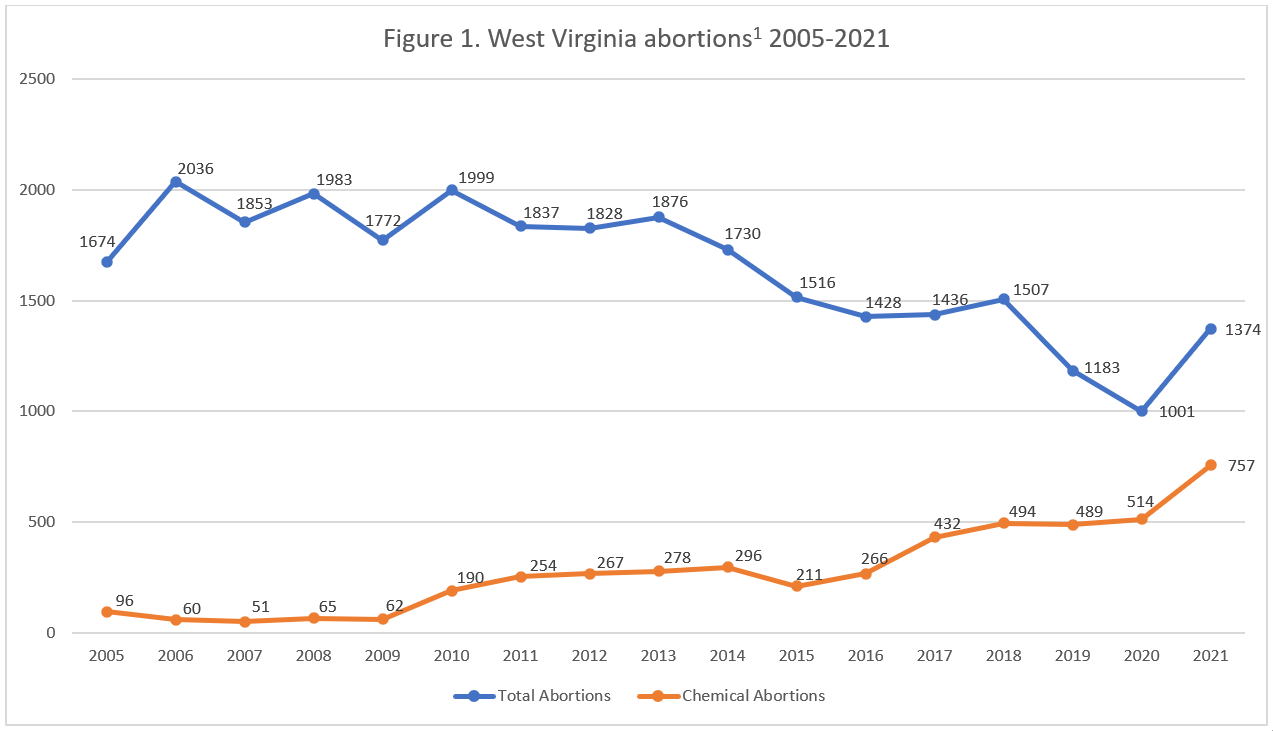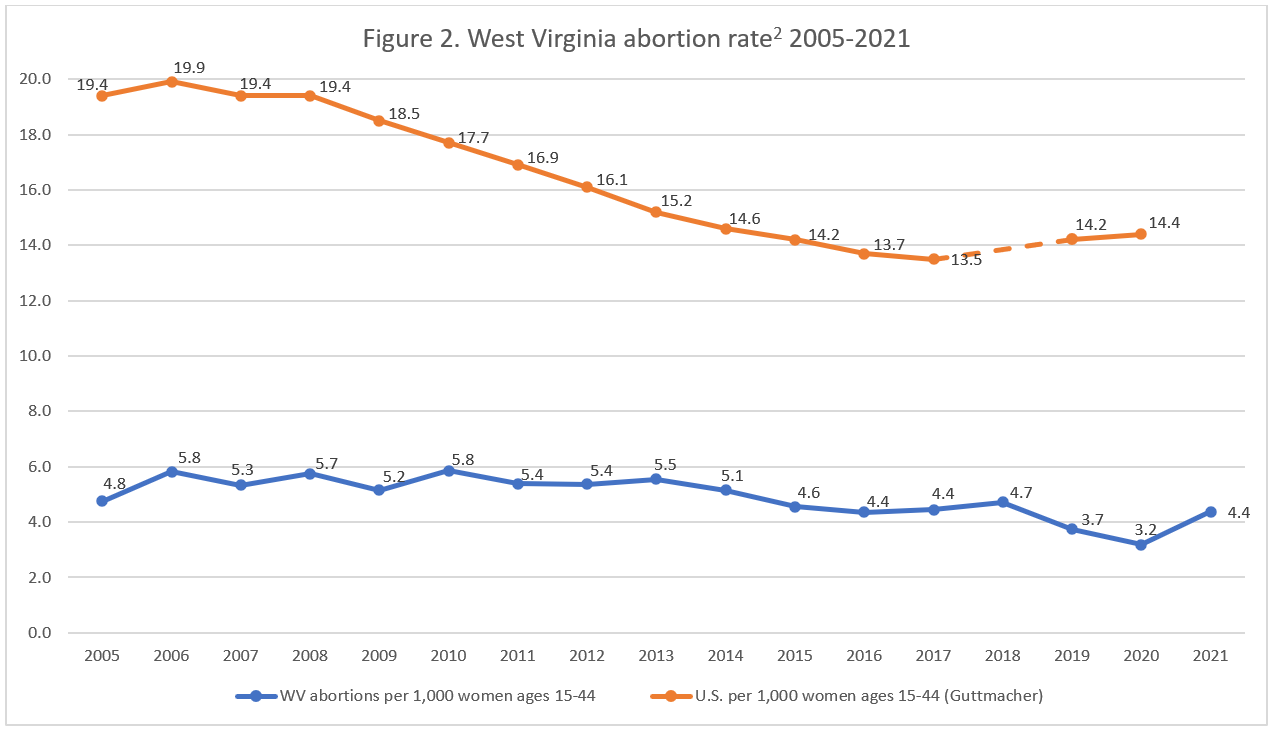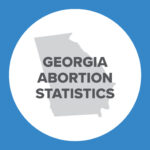Abortion Reporting: West Virginia (2021)
West Virginia’s 2021 abortion statistics were published in August of 2022, showing that abortions in the Mountain State have increased since 2020.
Statistics and Changes in West Virginia Abortions, 2020-2021

The report does not include information on Planned Parenthood’s West Virginia abortion market share, but Planned Parenthood operates no abortion centers in West Virginia.
Abortion Totals and Trends
In 2021, there were 1,374 abortions reported in West Virginia, an increase of 37 percent from the previous year (Fig. 1). This followed a drop of 15 percent between 2019 and 2020. Chemical abortions increased by 47 percent from 514 in 2020 to 757 in 2021, making up 55 percent of the total in 2021 (Fig. 1). The Charlotte Lozier Institute (CLI) estimates that West Virginia’s abortion rate in 2021 was 4.4 abortions per 1,000 women ages 15 to 44, up 37 percent from 2020 (Fig. 2). As of October 2022, 23 states had released 2021 abortion statistics, of which 16 reported that abortions had increased from the previous year.
State Report Summary
West Virginia’s last full abortion report is for 2018, but the state has published separate reports with 2019, 2020, and 2021 data collected as required by its Pain-Capable Unborn Child Protection Act. The Act limits abortion at 22 weeks of gestation, except to save a woman’s life or a major bodily function, or in cases in which the unborn baby has a medical condition that the physician deems would prevent him or her from surviving outside the womb.
Sixty-six percent of the abortions reported in West Virginia in 2021 were performed at eight weeks of gestation or earlier. Eighteen percent occurred between nine and 10 weeks, and seven percent were performed between 11 and 12 weeks gestation. Six percent were performed between 13 and 15 weeks, and two percent were performed between 16 and 19 weeks. There were six abortions at 20 weeks of gestation or later; the report does not indicate whether any of these were performed after 22 weeks. In 2020, three abortions were performed at or after 20 weeks of gestation, for a total of nine abortions after 20 weeks between 2020 and 2021.
Governor Jim Justice (R) signed HB2982 in April 2021. This bill requires informed consent when women undergo chemical abortions, including the provision of information about abortion pill reversal.
All six of the post-20-week abortions reported in 2021 were performed because unborn babies were termed “non-medically viable.” The unborn babies’ conditions included anencephaly, Trisomy 18, fetal skeletal dysplasia, renal agenesis, severe Dandy-Walker malformation, and single ventricle. One of the abortions was performed using a method that gave the baby the best chance of survival, while in five cases, the method of abortion was not chosen to give the baby the greatest chance of survival.
In 2021, 55 percent of West Virginia abortions were chemical abortions, while 44 percent were performed using dilation and curettage. There were eight dilation and evacuation procedures (not quite one percent).
West Virginia publishes information on its informed consent process in a separate report. The most recent report is for 2019.
West Virginia’s 2021 report contains no information on the age, race, marital status, or pregnancy history of women who obtained abortions in the state. However, West Virginia shares demographic information with the Centers for Disease Control and Prevention (CDC) to be included in the annual abortion surveillance reports. The most recent CDC abortion surveillance report is for 2019 and was described in CLI’s abortion report on West Virginia’s 2020 data.
Legislative Changes
After Roe v. Wade (1973) was overturned, West Virginia’s Governor signed HB302 into law in September 2022 and it immediately went into effect. The law prohibits abortion at all stages of pregnancy. The law has exemptions for medical emergencies and for rape and incest until eight weeks of pregnancy for adults and 14 weeks for minors. The law also requires that surgical abortions can only be performed at a state-licensed hospital by a physician with hospital privileges. This law was enacted after West Virginia’s pre-Roe legislation to prohibit abortion was blocked from enforcement in July 2022.
In response to the newly passed legislation, the sole operating abortion center in West Virginia, Women’s Health Center of West Virginia, immediately suspended abortions.
State Ranking
In 2016, CLI analyzed abortion reporting across the 50 states, the District of Columbia, and New York City. West Virginia tied for 21st best. To improve its reporting, West Virginia could release a full report that includes both the information that it publishes in its Pain-Capable Unborn Child Protection Act reports and the information the state reports to the CDC. Additionally, West Virginia could collect and report data on complications caused by abortion, as many other states do. This data is increasingly important with the increased distribution of abortion pills which are associated with higher complication rates to women.


- Total and chemical abortions for 2005-2015 were taken from CDC surveillance reports. Totals for 2016-2020 were taken from West Virginia’s 2020 abortion report.
- Rates were calculated by CLI using the following formula: (total number of abortions performed in West Virginia ÷ number of resident women ages 15-44) x 1,000. Rates may differ slightly from previous CLI articles due to revised population estimates. Population estimates were obtained from the CDC WONDER database. Estimates for 2005-2009 are intercensal estimates of the July 1 resident population. Estimates for 2010-2019 are Vintage 2020 postcensal estimates of the July 1 resident population. Estimates for 2020-2021 are Vintage 2021 postcensal estimates of the July 1 resident population. Estimates were produced by the U.S. Census Bureau and the National Center for Health Statistics.

























